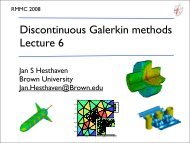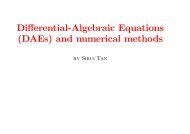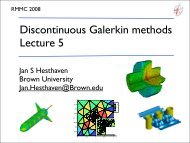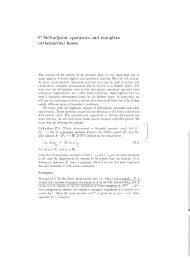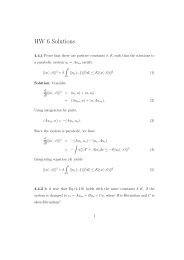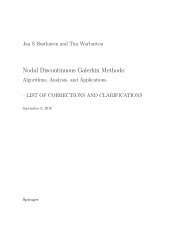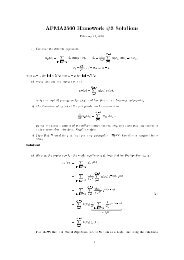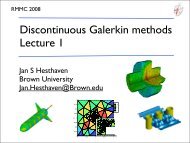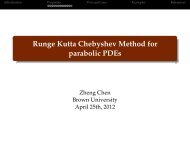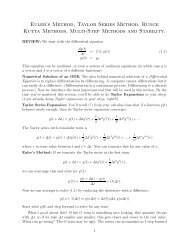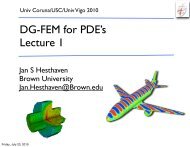MULTI-ELEMENT GENERALIZED POLYNOMIAL CHAOS FOR ...
MULTI-ELEMENT GENERALIZED POLYNOMIAL CHAOS FOR ...
MULTI-ELEMENT GENERALIZED POLYNOMIAL CHAOS FOR ...
Create successful ePaper yourself
Turn your PDF publications into a flip-book with our unique Google optimized e-Paper software.
910 XIAOLIANG WAN AND GEORGE EM KARNIADAKIS<br />
which yields that<br />
(2.38)<br />
(πi+1,πi+1) ≤ ((τ − αi)πi, (τ − αi)πi).<br />
The proof concludes by noting that a ≤ αi ≤ b.<br />
Thus, if the element is small, the L2 norm of πi will lead to underflow quickly.<br />
In practice, we rescale the random elements with finite boundaries by the following<br />
linear transformation:<br />
(2.39)<br />
ξk,i = bk,i − ak,i<br />
2<br />
Yk,i + bk,i + ak,i<br />
,<br />
2<br />
where we map the random variable ξ k defined in element k to a random variable Y k<br />
defined in [−1, 1] d . The PDF of Y k can be obtained as<br />
(2.40)<br />
� �<br />
�<br />
¯f(y k) = det �<br />
∂ξ �<br />
k �<br />
�∂y<br />
�<br />
k<br />
ˆ f(ξk(y k)) = f(ξk(y k))<br />
Pr(IBk =1)<br />
d�<br />
i=1<br />
bk,i − ak,i<br />
.<br />
2<br />
Compared to ξk, Y k are much more tractable for the numerical construction of orthogonal<br />
polynomials as demonstrated in section 3.1.1. After such a transformation is<br />
employed, we can apply the ME-gPC scheme with respect to the new random variable<br />
Y k instead of the random variable ξk. Note that such a mapping is usually unnecessary<br />
for random elements with at least one infinite boundary because these elements<br />
can be related to a small probability Pr(IBk = 1).<br />
We now summarize the overall ME-gPC algorithm.<br />
Algorithm 2.1 (ME-gPC).<br />
–Step 1: build a stochastic ODE system by gPC<br />
–Step 2: perform the decomposition of random space adaptively<br />
– time step i: from1to M<br />
– loop all the random elements<br />
– if η γ<br />
k Pr(IBk =1)≥θ1 –<br />
in element k, then<br />
if rn ≥ θ2 · maxj=1,...,d rj, then<br />
– split random dimension ξn into two equal ones ξn,1 and ξn,2<br />
– map ξn,1 and ξn,2 to Yn,1 and Yn,2 defined on [−1, 1]<br />
– construct one-dimensional orthogonal polynomials for Yn,1 and Yn,2<br />
– end if<br />
– construct d-dimensional orthogonal polynomials using tensor products<br />
– map information to children elements<br />
– end if<br />
– update the information by the gPC method<br />
– end element loop<br />
– end time step<br />
–Step 3: postprocessing stage<br />
Remark 2.1 (C0 continuity in random space). In the ME-gPC scheme, we deal<br />
with the stochastic problem locally without considering the interface between two<br />
random elements; in other words, we split the original problem into N independent<br />
ones. The reason is that all the statistics are in Lq sense, which means that the<br />
statistics are determined by up to qth moments of the desired random field. Thus,<br />
the continuity<br />
(2.41)<br />
uB1(ξ) =uB2(ξ), ξ ∈ ¯ B1 ∩ ¯ B2,



